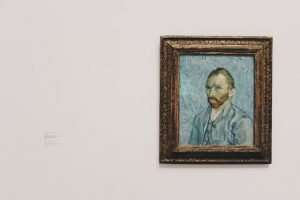Artists often don’t know how to sell their work. Are you one of them?
Have you ever wondered how an artist should sell art online? Whether its best to sell your original art or prints?
What if you have a studio and don’t do the work yourself, but rather hire people to do the work for you, should you still be selling your own art?
I’m sure there are many artists out there who wonder about all this stuff, so I decided to write a blog about it.
There are a lot of ways to sell your original art, and it’s super useful to have a “career strategy” in place as you’re starting out. Here’s the problem with that, though: what if you don’t know what your career is going to look like?
There are so many conflicting opinions on the subject, and everyone has a different idea about what sells art and what doesn’t. And let’s not forget: we’re artists! We don’t necessarily want to be selling our art. (It should be selling itself!)
But what if you do want to make money from your art? How do you set up a plan — or make one up as you go along — that is going to work for you?
In this blog post I’m going to lay out my own strategy for selling my art. But first, let’s talk about why I even wanted to sell my art in the first place…
Selling original art is a challenge. Take for example the difficulty of knowing what to price it at, which can only really be achieved by having experience selling your art. With experience you will learn where your art is good and where it is bad and how much to charge on a piece-by-piece basis.
To sell your art online you need an online presence, so that prospective buyers can find you. A blog is often used as a way of providing this presence, but is it the best way?
Having an online presence in the form of a blog has two main benefits. One is that people can contact you directly, rather than having to do their own research (which may not be easy if they don’t already know who you are). The other benefit is that other sites such as eBay or Etsy can link to your blog, increasing its exposure and making it easier for people to find who might be interested in purchasing some of your original art.
It’s easy enough to set up a blog for your artwork – there are plenty of free ones out there – but what about the content? Where do you begin? Luckily there are lots of resources available for learning about blogging. However, many of these resources assume that you already have an established website – something that
If you are a fine artist and you have just finished a piece of original art, you might be asking yourself what you should do with it now. You just finished this masterpiece and now you want to know how can I sell it? Well, if you want to make the most money for your fine artwork then understand that there are quite a few factors involved in the decision about how to sell it.
Describe how to sell an original artwork:
The Art Seller’s Handbook
Art dealers work in a very similar way to car dealers. They buy old paintings and then they resell them at a higher price than what they paid for them. This is why they are called art dealers instead of art buyers.
One way of selling an original painting is by using an art gallery. The owner of the gallery will then take a percentage of the sale as commission and will promote the artist’s work through their gallery space and website. Some galleries will also help promote your work by sending out press releases or even hosting an exhibition in your honor.
There are many different types of galleries, some specialize in specific mediums such as photography or sculpture, while others focus on contemporary art or traditional paintings and drawings. The best thing about using a gallery is that it is free since the
Of course, the best strategy is to get your art into a reputable gallery. However, as with any business, there are strategies you can use to help sell more art on your own.
The first thing to understand is that you need to make a good product. People won’t buy your art if it isn’t any good. It’s important to surround yourself with other artists who will give you honest and constructive feedback so that you can improve your skills. Once you have created a good product, then it is time to start selling!
I’ve been working as an artist for over 20 years and I still struggle with selling my work. It’s easy to get caught up in creating new work and forget that you need to sell the work you’ve already created. I’ve had the luxury of making my living as an artist for most of my career but I know many artists who supplement their income with another job or just don’t make enough money from their art sales to live off of.
This blog post is about how I’ve learned to market myself without relying on galleries or consignment shops and what has worked for me as well as sharing some tips and advice from other artists who have learned how to market themselves without relying on galleries or consignment shops.
In the past, people used to paint their portraits in a portrait studio. This didn’t mean that they had their picture taken by a camera, it meant that they hired a professional artist to paint their portrait.
The portrait studio was the place where all of the paintings were done. The artists would go there and paint whatever portraits they could — this was usually not where people would come to get their portraits painted; they would go to the artist’s personal studio.
The art studio idea is pretty brilliant — you’ve got a bunch of people all coming together to work on the same thing. And it’s not just because they’re all working on the same thing that’s good; it’s also because they’re competing with each other and inspiring each other. There’s an energy created where everyone is trying to outdo one another and make better and better paintings.
This can apply to any kind of creative work: music, writing, film making, etc… So many creative people do their best work when working around others who are doing great work too.
But here’s the thing: art studios don’t really exist anymore. In fact, you could argue that with the Internet, we now have a globally connected art studio where everyone can participate and everyone can reach a global
Lovecraft, like the other pulp writers of the day, wrote for a male audience. Women were not considered part of the reading public. Often, when women read his stories, it was because their husbands and boyfriends had recommended them. And many of the women who read him came to hate his fiction with a passion. They felt that his stories degraded women and reduced them to helpless damsels in distress. He was accused of being a misogynist and an anti-Semite and it was partly because of this backlash that Lovecraft was never able to make much money from his writing.
Indeed, in one letter to Frank Belknap Long he writes: “the more I see of the literary world—its petty jealousies & rivalries & bickerings & its snobbery & backbiting—the more I realise how lucky I am in having nothing to do with it…”



